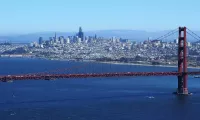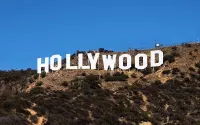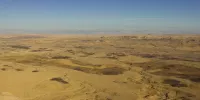Las Vegas, Nevada's most populous city and the seat of Clark County, is a major resort city renowned for gambling, shopping, fine dining, entertainment, and nightlife. Its metropolitan area is the 29th largest in the U.S., with approximately 2.4 million residents. The city's main attractions are concentrated in downtown Las Vegas and on the Las Vegas Strip, located in the unincorporated towns of Paradise and Winchester. Las Vegas Valley serves as Nevada's leading financial, commercial, and cultural center.
1905: Las Vegas Founded as a City
Las Vegas was founded as a city in 1905, when 110 acres of land adjacent to the Union Pacific Railroad tracks were auctioned in what would become the downtown area.
1905: Las Vegas settled
Las Vegas was settled in 1905.
1909: Las Vegas's largest snowfall on record
Unofficially, Las Vegas's largest snowfall on record was the 12 inches that fell in 1909.
1911: Las Vegas Incorporated as a City
In 1911, Las Vegas was incorporated as a city.
1929: Welcome Arch Installation
In 1929, the city installed a welcome arch over Fremont Street, at the corner of Main Street. It remained in place until 1931.
1931: Welcome Arch Removal
In 1929, the city installed a welcome arch over Fremont Street, at the corner of Main Street. It remained in place until 1931.
1931: Opening of the Northern Club
In 1931, the Northern Club (now the La Bayou) opened.
1931: Nevada legalized casino gambling and reduced residency requirements for divorce
The year 1931 was pivotal for Las Vegas. At that time, Nevada legalized casino gambling and reduced residency requirements for divorce to six weeks. This year also witnessed the beginning of construction of the tunnels of nearby Hoover Dam.
1935: Construction of Hoover Dam completed
In 1935, the construction work on the Hoover Dam was completed, after an influx of construction workers and their families helped Las Vegas avoid economic calamity during the Great Depression.
January 25, 1937: Lowest temperature recorded
On January 25, 1937, the lowest temperature of 8 °F (−13 °C) was recorded in Las Vegas.
1941: Las Vegas Army Airfield established
In late 1941, the Las Vegas Army Airfield was established.
1950: Nellis Air Force Base
In 1950, Las Vegas Army Airfield was renamed Nellis Air Force Base and became home to the United States Air Force Thunderbirds aerobatic team.
1951: Nuclear weapons testing began at the Nevada Test Site
In 1951, nuclear weapons testing began at the Nevada Test Site, 65 miles northwest of Las Vegas, giving the city the nickname "Atomic City".
1955: Moulin Rouge Hotel Opens
In 1955, the Moulin Rouge Hotel opened and became the first racially integrated casino-hotel in Las Vegas.
1959: Welcome to Fabulous Las Vegas sign installed
In 1959, the 25-foot-tall Welcome to Fabulous Las Vegas sign was installed at the south end of the Las Vegas Strip.
January 13, 1963: Lowest temperature recorded
On January 13, 1963, the lowest temperature of 8 °F (−13 °C) was recorded in Las Vegas.
1963: Low temperature measured in Las Vegas
In 1963, a temperature of 29 °F (−2 °C) was measured in Las Vegas.
1963: Nuclear tests moved underground
In 1963, the Partial Nuclear Test Ban Treaty required nuclear tests be moved underground.
1972: Las Vegas Motor Speedway Construction
In 1972, the Las Vegas Motor Speedway, a 1.5 mile tri-oval, was constructed.
1973: Las Vegas Metropolitan Police Department Formed
In 1973, the Las Vegas Metropolitan Police Department was formed through the merger of the Las Vegas Police Department and the Clark County Sheriff's Department.
1980: First all-new hotel-casino
In 2020, Circa Resort & Casino opened, becoming the first all-new hotel-casino to be built on Fremont Street since 1980.
1989: The Mirage Opened
When The Mirage opened in 1989, it started a trend of major resort development on the Las Vegas Strip outside of the city. This resulted in a drop in tourism in the downtown area.
1990: Population growth accelerated
The population growth accelerated since the 1960s and into the 21st century, between 1990 and 2000 the population increased by 85.2%.
1995: Fremont Street Experience Opened
In 1995, the Fremont Street Experience opened in Las Vegas's downtown area. This canopied five-block area features 12.5 million LED lights and 550,000 watts of sound from dusk until midnight during shows held at the top of each hour.
1997: Cessation of Amtrak Service via Desert Wind
Amtrak trains have not served Las Vegas since the service via the Desert Wind at Las Vegas station ceased in 1997.
1997: Allegiant Air Launched with Hub at Harry Reid International Airport
In 1997, Allegiant Air, a low-cost air carrier, was launched with its first hub at Harry Reid International Airport and headquarters in Summerlin.
1997: Amtrak Desert Wind Train Service Ceases Operation
Until 1997, the Amtrak Desert Wind train service ran through Las Vegas using the Union Pacific Railroad tracks. In 1997, the train service ceased operation.
2000: 2000 Census Data for the City of Las Vegas
According to the 2000 census, Las Vegas had a population of 474,434 people and a specific racial makeup.
2000: Land-swap deal with Lehman Brothers
In 2000, the city conducted a land-swap deal with Lehman Brothers, acquiring 61 acres of property near downtown Las Vegas in exchange for 91 acres of the Las Vegas Technology Center.
2000: Population growth accelerated
The population growth accelerated since the 1960s and into the 21st century, between 1990 and 2000 the population increased by 85.2%.
2002: Drought Prompts Water Conservation Efforts
In 2002, a drought led to the implementation of water conservation efforts in the Las Vegas Valley.
2002: Replica Welcome Sign Installed
In 2002, a replica of the Welcome to Fabulous Las Vegas sign, standing nearly 16 feet tall, was installed within city limits at Las Vegas Boulevard and Fourth Street.
2002: Climate change concerns due to drought
In the wake of a 2002 drought, concerns about climate change led to a reduction in daily water consumption.
2003: Reduction in daily water consumption
Due to concerns about climate change in the wake of a 2002 drought, daily water consumption has been reduced from 314 US gallons per resident in 2003 to around 205 US gallons in 2015.
2004: Study reveals high divorce rates in Las Vegas
According to a 2004 study, Las Vegas has one of the highest divorce rates, partially due to Nevada's nonrestrictive requirements for divorce.
2004: Symphony Park Announced
In 2004, Las Vegas Mayor Oscar Goodman announced that the area from the land-swap would become home to Symphony Park, a mixed-use development.
July 19, 2005: Record hot daily minimum
On July 19, 2005, the official record hot daily minimum was 95 °F (35 °C).
2005: World Market Center Opens
In 2005, the World Market Center, consisting of three large buildings spanning 5,400,000 square feet, opened. This center hosts trade shows for the furniture and furnishing industries twice a year.
December 17, 2008: Significant snow accumulations
On December 17, 2008, significant snow accumulations occurred in Las Vegas.
2008: EPA grant funds growth and environmental effects analysis
In 2008, a U.S. Environmental Protection Agency grant funded a program that analyzed and forecast growth and environmental effects through 2019.
March 2010: RTC Launched Bus Rapid Transit Link
In March 2010, the RTC launched bus rapid transit link in Las Vegas called the Strip & Downtown Express with limited stops and frequent service that connects downtown Las Vegas, the Strip and the Las Vegas Convention Center. Shortly after the launch, the RTC dropped the ACE name.
2010: 2010 Census Data for the City of Las Vegas
According to the 2010 Census, the city of Las Vegas had a population of 583,756. The city's racial composition had shifted slightly.
2011: Las Vegas Valley Water Usage Data
In 2011, the Las Vegas Valley used a certain amount of water, to which the consumption increased by 1.2 billion US gallons in 2014.
2012: "The Year of Downtown"
2012 was dubbed "The Year of Downtown" due to the completion of numerous revitalization efforts, including the Smith Center for the Performing Arts, the Discovery Children's Museum, the Mob Museum, the Neon Museum, a new City Hall complex, and renovations for a new Zappos.com corporate headquarters in the old City Hall building.
February 2013: City Hall Moved and Zappos.com Occupied Former Building
In February 2013, city offices moved to a new Las Vegas City Hall on downtown's Main Street. Also in February 2013, the former city hall building became the corporate headquarters for Zappos.com.
July 1, 2013: Record hot daily minimum
On July 1, 2013, the official record hot daily minimum was 95 °F (35 °C).
2013: Zappos.com Moves Headquarters to Downtown Las Vegas
In 2013, Zappos.com, which is now an Amazon subsidiary, moved its headquarters from San Francisco to downtown Las Vegas.
2014: Las Vegas Valley Increased Water Usage
In 2014, the Las Vegas Valley used 1.2 billion US gallons more water than in 2011, indicating a significant rise in water consumption despite conservation efforts.
May 2015: Las Vegas North Premium Outlets Second Expansion Completed
In May 2015, the second expansion of the Las Vegas North Premium Outlets was completed, bringing the total number of stores to 175.
December 25, 2015: Snow accumulation in Las Vegas
On December 25, 2015, Las Vegas experienced significant snow accumulations.
2015: Reduction in daily water consumption
Due to concerns about climate change in the wake of a 2002 drought, daily water consumption has been reduced from 314 US gallons per resident in 2003 to around 205 US gallons in 2015.
2015: Percentage of Households Without Cars
In 2015, 10.2 percent of city of Las Vegas households were without a car, which increased slightly to 10.5 percent in 2016.
2016: Commuting Statistics
In 2016, 77.1 percent of working Las Vegas residents commuted by driving alone. About 11 percent commuted via carpool, 3.9 percent used public transportation, and 1.4 percent walked. About 2.3 percent of Las Vegas commuters used all other forms of transportation, including taxi, bicycle, and motorcycle. About 4.3% of working Las Vegas residents worked at home.
2016: Replica Welcome Sign Destroyed
In 2016, the replica Welcome to Fabulous Las Vegas sign was destroyed when a pickup truck crashed into it.
2017: Vegas Golden Knights Inaugural Season
In 2017, the Vegas Golden Knights, an expansion team of the National Hockey League (NHL), began playing their inaugural season at T-Mobile Arena.
2018: Installation of Neon Showgirls
In 2018, giant neon showgirls were initially added as part of a $400,000 welcome display just north of the Strat. The showgirls were 25 feet tall.
2018: City approved plans for new gateway landmark
In 2018, the city approved plans for a new gateway landmark in the form of neon arches.
February 18, 2019: Snow accumulation in Las Vegas
On February 18, 2019, parts of Las Vegas received about 1 to 2 inches of snow.
2019: Commute times and digital connectivity in Las Vegas
Between 2019 and 2023, the mean travel time to work for residents aged 16 and older was approximately 25.8 minutes. The vast majority of households in Las Vegas are digitally connected, with 95.6% having a computer and 89.1% subscribing to broadband internet services.
2019: Household data
From 2019 to 2023, Las Vegas had approximately 244,429 households, with an average of 2.63 persons per household. About 55.7% of housing units were owner-occupied, and the median value of owner-occupied housing was $395,300. Median gross rent during this period was $1,456 per month (in 2023 dollars).
2019: Income and poverty levels in Las Vegas
From 2019 to 2023, the median household income in Las Vegas was $70,723, while the per capita income was $38,421 (in 2023 dollars). Approximately 14.2% of the population lived below the poverty line during the same period.
2019: EPA grant funds growth and environmental effects analysis
In 2008, a U.S. Environmental Protection Agency grant funded a program that analyzed and forecast growth and environmental effects through 2019.
2020: 2020 United States Census Data for Las Vegas
According to the 2020 United States census, the city of Las Vegas had 644,883 people living in 244,429 households. The racial composition of the City of Las Vegas was 49.2% white, 11.9% black, 1.1% American Indian or Alaska Native, 6.9% Asian, Hispanic or Latino residents of any race were 34.1% and 16.2% from two or more races. 40.8% were non-Hispanic white.
2020: Clark County Census Data
As of the 2020 Census, Clark County had a population of 2,265,461 people, with approximately 1,030,000 living in unincorporated Clark County.
2020: Circa Resort & Casino Opens
In 2020, Circa Resort & Casino opened, becoming the first all-new hotel-casino to be built on Fremont Street since 1980.
2020: Gateway Arches project completed
In 2020, the Gateway Arches project, built by YESCO, was completed within city limits in front of the Strat resort, costing $6.5 million and standing 80 feet high.
2020: Las Vegas Raiders Relocated from Oakland
In 2020, the Las Vegas Raiders of the National Football League (NFL) relocated from Oakland, California, and began playing at Allegiant Stadium.
2020: Las Vegas population at 641,903
In 2020, the census recorded the population of Las Vegas at 641,903 residents, making it the 24th-most populous city in the United States. The Las Vegas metropolitan area had an estimated 2.4 million residents and ranked as the 29th-largest metropolitan area in the nation in 2020.
2022: Replacement of Neon Showgirls
In 2022, the original neon showgirls were replaced by new ones rising 50 feet tall.
2023: Las Vegas attracts over 40.8 million visitors annually
As of 2023, Las Vegas attracts over 40.8 million visitors annually, making it one of the most visited cities in the United States and consistently ranking among the world's top tourist destinations.
2023: Commute times and digital connectivity in Las Vegas
Between 2019 and 2023, the mean travel time to work for residents aged 16 and older was approximately 25.8 minutes. The vast majority of households in Las Vegas are digitally connected, with 95.6% having a computer and 89.1% subscribing to broadband internet services.
2023: Household data
From 2019 to 2023, Las Vegas had approximately 244,429 households, with an average of 2.63 persons per household. About 55.7% of housing units were owner-occupied, and the median value of owner-occupied housing was $395,300. Median gross rent during this period was $1,456 per month (in 2023 dollars).
2023: Income and poverty levels in Las Vegas
From 2019 to 2023, the median household income in Las Vegas was $70,723, while the per capita income was $38,421 (in 2023 dollars). Approximately 14.2% of the population lived below the poverty line during the same period.
July 7, 2024: Highest Temperature Observed in Las Vegas
On July 7, 2024, the highest temperature officially observed for Las Vegas was 120 °F (48.9 °C), as measured at Harry Reid International Airport.
July 2024: Hottest Month Ever Recorded in Las Vegas
July 2024 was the hottest month ever recorded in Las Vegas, with its highest recorded mean daily average temperature over the month of 99.9 °F (38 °C), its highest recorded mean daily maximum temperature of 111.5 °F (44 °C), and its highest recorded mean nightly minimum temperature of 88.3 °F (31 °C).
2024: Symphony Park residential units total 600
As of 2024, Symphony Park is home to the Cleveland Clinic Lou Ruvo Center for Brain Health, The Smith Center for the Performing Arts, the Discovery Children's Museum, the Las Vegas Chamber of Commerce, and four residential projects totaling 600 residential units.
2024: Brightline West Construction Begins
In 2024, construction began on the Brightline West high-speed rail project to connect Brightline's Las Vegas station and the Rancho Cucamonga station in Greater Los Angeles.
2028: Athletics of Major League Baseball to Move to Las Vegas
It was announced that by 2028, the Athletics of Major League Baseball (MLB) will move to Las Vegas.
Mentioned in this timeline

San Francisco is a major commercial financial and cultural hub...

Los Angeles is the most populous city in California and...
Arizona is a landlocked state in the Southwestern U S...

A car also known as an automobile is a wheeled...

A desert is a landscape characterized by minimal precipitation leading...
Nevada a landlocked state in the Western US is the...
Trending

3 months ago Rockets face challenges with VanVleet's injury, consider trade targets for replacement.

2 months ago Deni Avdija wins in Utah, builds something special in Portland, breaks out for Blazers.
24 days ago HBO Max Offers Huge Black Friday Discount: One Year for Just $36!
7 months ago HBO's 'Mountainhead' skewers tech elite in a satisfying end-of-world satire.

2 months ago Carmelo Anthony's NBA on NBC Debut Outfit Sparks Controversy and Fan Jokes
15 days ago Druski's comedy: Viral video, 'hatfishing' skit, and hosting Billboard 2025 livestream.
Popular

Candace Owens is an American conservative political commentator and author...

Tucker Carlson is an American conservative political commentator known for...

XXXTentacion born Jahseh Dwayne Ricardo Onfroy was a controversial yet...

Ilhan Omar is an American politician currently serving as the...

Kashyap Pramod Patel is an American lawyer who became the...

Frederick Christ Trump Sr - was an American real estate...
